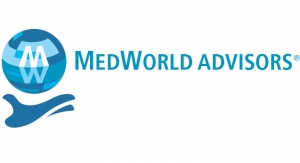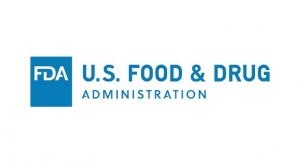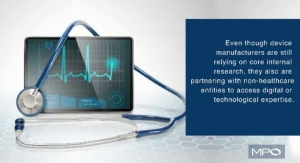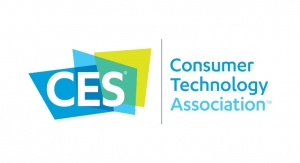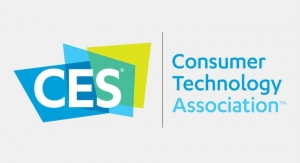Bryant Headley, Customer Success Executive, MasterControl05.01.19
Companies developing cutting-edge medical devices need cutting-edge technology for their business processes. Whether a company focuses on finding new device materials, designing non-invasive monitors, or tackling the regulatory process, medtech is advancing too fast for paper-based processes. In a digital age, companies continuing to use paper-based processes will be left behind. For medtech companies in particular, digitization is taking over, and rightfully so—it’s key to conducting clinical trials, navigating the regulatory gauntlet, getting products to market faster, and tracking adverse events post-market. Many companies have embraced this idea and updated their processes to include software solutions replacing paper-based quality management, manufacturing production records, and regulatory information management. A step in the right direction, but it isn’t enough.
Companies that have taken a fragmented approach to digitization have likely wound up with various software solutions from different vendors to accommodate different departments. This may be a step up from using paper, but it’s far from ideal. A company can never reach full potential if it operates in silos. Keeping up with medtech industry trends requires a certain amount of interconnectivity that is hard, if not impossible, to achieve without automated solutions that enable communication between multiple departments.
Top 4 Medtech Trends Where Digitization Gives You an Edge
While some medtech companies have gone full speed ahead with digitization, others have clung to paper-based processes with the “if it ain’t broke, don’t fix it” adage. These processes may have previously been sufficient, but the industry is fast approaching a point where compliance will be impossible with paper. It’s ironic companies that develop products with cutting-edge technology are hesitant to embrace technology for business processes. Whatever the reasons companies have for not embracing automated solutions, the benefits will always outweigh the risks. And in a constantly changing industry, adopting software solutions becomes less about getting ahead and more about keeping up.
1. Tracking and complying with new regulations. Companies dealing with healthcare products tend to have a long list of regulations that grow and evolve over time, and regulatory bodies expect companies to stay current and provide documentation to prove it. This is certainly the case with medtech, as shown by new regulations imposed by the U.S. Food and Drug Administration (FDA), the European Union’s Medical Device Regulation (MDR), and updates to ISO 13485. New regulations and standards frequently mean at least one product development aspect must be changed in some way. Keeping track of and complying with these new regulations is nearly impossible with paper-based processes for quality and manufacturing management—it’s a different story for companies that have digitized.
An automated solution for device registration and submissions management helps keep track of regulatory changes and new requirements in various global markets. However, streamlining these processes is possible on a much greater scale using integrated solutions that enable seamless organizational collaboration. By digitizing quality and manufacturing management processes, companies have an easier time compiling, routing, revising, and publishing large amounts of required documentation and training. They can also view the entire registration or submission’s lifecycle to avoid bottlenecks and decrease turnaround time. Digitization facilitates mastering regulatory requirements in multiple countries and taking control of a global supply chain, which increases market access.
2. Optimizing human factors engineering. Human factors engineering is the process of observing and gathering scientific data about human behavior, such as learning styles, abilities, and limitations to develop devices intended users can intuitively operate. Specifically, medical device developers must consider the device, its use environment, and its intended users to eliminate as many risks as possible. This is especially important when designing healthcare products, as user error can mean the difference between life and death. Certain regulations contain elements of human factors engineering, making it part of the medical device product development process. The FDA, for example, requires a Human Factors Engineering or Usability Engineering report in a premarket submission with its own specific set of requirements.
One of these requirements is to control and eliminate risk as much as possible. The risks human factors engineering identifies must have corresponding risk mitigation strategies. Effective risk management is much easier with integrated technology solutions. Risk management functionality is usually included in a quality management system (QMS). If a company purchases a QMS from one vendor and a regulatory information management system (RIMS) from another, risk mitigation becomes complex. If the two systems cannot integrate, data and information sharing must be manual. This is time-consuming and prone to human error, whereas two systems on the same platform can communicate without requiring human interaction.
3. Lowering the barriers to entry. Highly regulated industries operate in markets with many barriers to entry, which should be comforting to established medtech companies unwilling to lose market share. However, in other industries those barriers either don’t exist or are easily overcome by goliaths. Pharmaceutical and tech companies are venturing into the medtech space with the resources to overcome the obstacles of entering a new market. Pharmaceutical companies are accustomed to operating in a highly regulated environment and tech companies already have the resources for designing and manufacturing complex technology products. Either is in a good position to break into the medtech industry.
This might not bode well for existing medtech companies, especially those on the smaller side or that manufacture relatively few products. For businesses concerned about increased competition, the best course of action is to digitize. This represents a substantial investment and helps products travel the development process faster while maintaining compliance. Digitizing automates critical processes commonly requiring significant time and manpower. Beyond automation, digitization allows companies to meet compliance regulations faster with fewer issues—especially if they’re already in the industry and know the regulations.
4. Securing devices and data. The specialized knowledge tech companies possess is one reason they’re poised to break into medtech. Their technology expertise gives them a distinct advantage over incumbent medtech companies. However, the general tech industry doesn’t have the same strict requirements as healthcare companies or those that store and use protected health information. The Health Insurance Portability and Accountability Act (HIPAA) and Federal Food, Drug and Cosmetic Act (FD&C Act) apply to some medtech companies, depending on the information they handle. In some cases, a security breach can adversely impact patient health; this risk doesn’t generally exist in the tech industry. Medtech also has more regulations than the general tech industry. For example, last year the FDA released draft guidance indicating medical devices needed a cybersecurity bill of materials, which includes information about cybersecurity vulnerabilities and their exploitability.
Digitizing processes can help with this increasing problem. As far as preventing breaches goes, it probably can’t, but it will provide more security controls upfront. Having effective procedures in place for handling cybersecurity can reduce the risk of security breaches. Drafting the correct standard operating procedures (SOPs) and keeping them up to date is much easier with digitization. When dealing with highly sensitive patient data, have policies in place to provide proper data security, and train employees on those policies. Of course, it’s entirely possible to have paper-based SOPs. Keeping them updated, being able to find the latest version, and getting approvals in a timely manner are also technically possible, albeit extremely difficult on a non-digitized system.
Choosing a Solution
Once a company decides to digitize it proceeds by looking at the entire organization’s needs and how each department interacts. Taking a piecemeal approach to digitization guarantees the problem will be revisited further down the road—which has happened with electronic health records (EHRs). When healthcare organizations first started digitizing their processes, everyone hoped it would lead to better patient care. In some ways, it has. There are less medication errors, the coding process is more streamlined, and costs have been reduced. However, EHRs have hardly lived up to their hype. The reason is simple—different EHRs aren’t on speaking terms with each other.
If a patient’s primary care provider (PCP) has adopted an EHR and that patient has to visit the emergency room, in most cases, that hospital won’t have to access to the PCP’s records—which negates some of EHRs’ benefits. The same is true of companies that try to implement systems from different vendors across their organizations. The systems don’t interface with one another, severely limiting their effectiveness and keeping the organization from reaching its full potential.
Besides the administrative benefits of only dealing with one vendor, using solutions supported on the same platform allow the interoperability EHRs severely lack. Medtech companies need this connectivity to stay ahead of the curve in a constantly changing industry and keep up with new regulations and standards. One such perk is found in the quality/manufacturing relationship. These two departments certainly require unique solutions; however, when those solutions are connected, management has a better idea of what’s going on within the plant and the company.
A prime example of this is the FDA’s requirement for a written program for routine calibration of manufacturing equipment. This affects manufacturing because of the calibration aspect, and affects quality because of the written requirement. Because this requirement overlaps both departments, separate systems would almost certainly result in the same work being done multiple times. This is a common result of the left hand not knowing what the right hand is doing, which results in inefficiencies and noncompliance.
To maintain market share and meet regulatory requirements, medtech companies can no longer afford to procrastinate digitizing. The connectivity of the modern world requires software solutions be used, and common sense requires these solutions communicate with each other. Existing and future trends for medtech only reemphasize this point, as remaining competitive means using solutions that help meet regulatory requirements, design better products, secure those products, and stay one step ahead of competitors.
Bryant Headley has two decades of experience in regulatory compliance, technology, program management, and automating software systems in federal government agencies, including the FDA’s Office of Regulatory Affairs and the Office of Compliance and Business Integrity at the U.S. Department of Veteran Affairs (VA). He currently works with the sales, customer, and product development teams at MasterControl to facilitate success with governmental entities such as the FDA, VA, Department of Defense, and Department of Treasury.
Companies that have taken a fragmented approach to digitization have likely wound up with various software solutions from different vendors to accommodate different departments. This may be a step up from using paper, but it’s far from ideal. A company can never reach full potential if it operates in silos. Keeping up with medtech industry trends requires a certain amount of interconnectivity that is hard, if not impossible, to achieve without automated solutions that enable communication between multiple departments.
Top 4 Medtech Trends Where Digitization Gives You an Edge
While some medtech companies have gone full speed ahead with digitization, others have clung to paper-based processes with the “if it ain’t broke, don’t fix it” adage. These processes may have previously been sufficient, but the industry is fast approaching a point where compliance will be impossible with paper. It’s ironic companies that develop products with cutting-edge technology are hesitant to embrace technology for business processes. Whatever the reasons companies have for not embracing automated solutions, the benefits will always outweigh the risks. And in a constantly changing industry, adopting software solutions becomes less about getting ahead and more about keeping up.
1. Tracking and complying with new regulations. Companies dealing with healthcare products tend to have a long list of regulations that grow and evolve over time, and regulatory bodies expect companies to stay current and provide documentation to prove it. This is certainly the case with medtech, as shown by new regulations imposed by the U.S. Food and Drug Administration (FDA), the European Union’s Medical Device Regulation (MDR), and updates to ISO 13485. New regulations and standards frequently mean at least one product development aspect must be changed in some way. Keeping track of and complying with these new regulations is nearly impossible with paper-based processes for quality and manufacturing management—it’s a different story for companies that have digitized.
An automated solution for device registration and submissions management helps keep track of regulatory changes and new requirements in various global markets. However, streamlining these processes is possible on a much greater scale using integrated solutions that enable seamless organizational collaboration. By digitizing quality and manufacturing management processes, companies have an easier time compiling, routing, revising, and publishing large amounts of required documentation and training. They can also view the entire registration or submission’s lifecycle to avoid bottlenecks and decrease turnaround time. Digitization facilitates mastering regulatory requirements in multiple countries and taking control of a global supply chain, which increases market access.
2. Optimizing human factors engineering. Human factors engineering is the process of observing and gathering scientific data about human behavior, such as learning styles, abilities, and limitations to develop devices intended users can intuitively operate. Specifically, medical device developers must consider the device, its use environment, and its intended users to eliminate as many risks as possible. This is especially important when designing healthcare products, as user error can mean the difference between life and death. Certain regulations contain elements of human factors engineering, making it part of the medical device product development process. The FDA, for example, requires a Human Factors Engineering or Usability Engineering report in a premarket submission with its own specific set of requirements.
One of these requirements is to control and eliminate risk as much as possible. The risks human factors engineering identifies must have corresponding risk mitigation strategies. Effective risk management is much easier with integrated technology solutions. Risk management functionality is usually included in a quality management system (QMS). If a company purchases a QMS from one vendor and a regulatory information management system (RIMS) from another, risk mitigation becomes complex. If the two systems cannot integrate, data and information sharing must be manual. This is time-consuming and prone to human error, whereas two systems on the same platform can communicate without requiring human interaction.
3. Lowering the barriers to entry. Highly regulated industries operate in markets with many barriers to entry, which should be comforting to established medtech companies unwilling to lose market share. However, in other industries those barriers either don’t exist or are easily overcome by goliaths. Pharmaceutical and tech companies are venturing into the medtech space with the resources to overcome the obstacles of entering a new market. Pharmaceutical companies are accustomed to operating in a highly regulated environment and tech companies already have the resources for designing and manufacturing complex technology products. Either is in a good position to break into the medtech industry.
This might not bode well for existing medtech companies, especially those on the smaller side or that manufacture relatively few products. For businesses concerned about increased competition, the best course of action is to digitize. This represents a substantial investment and helps products travel the development process faster while maintaining compliance. Digitizing automates critical processes commonly requiring significant time and manpower. Beyond automation, digitization allows companies to meet compliance regulations faster with fewer issues—especially if they’re already in the industry and know the regulations.
4. Securing devices and data. The specialized knowledge tech companies possess is one reason they’re poised to break into medtech. Their technology expertise gives them a distinct advantage over incumbent medtech companies. However, the general tech industry doesn’t have the same strict requirements as healthcare companies or those that store and use protected health information. The Health Insurance Portability and Accountability Act (HIPAA) and Federal Food, Drug and Cosmetic Act (FD&C Act) apply to some medtech companies, depending on the information they handle. In some cases, a security breach can adversely impact patient health; this risk doesn’t generally exist in the tech industry. Medtech also has more regulations than the general tech industry. For example, last year the FDA released draft guidance indicating medical devices needed a cybersecurity bill of materials, which includes information about cybersecurity vulnerabilities and their exploitability.
Digitizing processes can help with this increasing problem. As far as preventing breaches goes, it probably can’t, but it will provide more security controls upfront. Having effective procedures in place for handling cybersecurity can reduce the risk of security breaches. Drafting the correct standard operating procedures (SOPs) and keeping them up to date is much easier with digitization. When dealing with highly sensitive patient data, have policies in place to provide proper data security, and train employees on those policies. Of course, it’s entirely possible to have paper-based SOPs. Keeping them updated, being able to find the latest version, and getting approvals in a timely manner are also technically possible, albeit extremely difficult on a non-digitized system.
Choosing a Solution
Once a company decides to digitize it proceeds by looking at the entire organization’s needs and how each department interacts. Taking a piecemeal approach to digitization guarantees the problem will be revisited further down the road—which has happened with electronic health records (EHRs). When healthcare organizations first started digitizing their processes, everyone hoped it would lead to better patient care. In some ways, it has. There are less medication errors, the coding process is more streamlined, and costs have been reduced. However, EHRs have hardly lived up to their hype. The reason is simple—different EHRs aren’t on speaking terms with each other.
If a patient’s primary care provider (PCP) has adopted an EHR and that patient has to visit the emergency room, in most cases, that hospital won’t have to access to the PCP’s records—which negates some of EHRs’ benefits. The same is true of companies that try to implement systems from different vendors across their organizations. The systems don’t interface with one another, severely limiting their effectiveness and keeping the organization from reaching its full potential.
Besides the administrative benefits of only dealing with one vendor, using solutions supported on the same platform allow the interoperability EHRs severely lack. Medtech companies need this connectivity to stay ahead of the curve in a constantly changing industry and keep up with new regulations and standards. One such perk is found in the quality/manufacturing relationship. These two departments certainly require unique solutions; however, when those solutions are connected, management has a better idea of what’s going on within the plant and the company.
A prime example of this is the FDA’s requirement for a written program for routine calibration of manufacturing equipment. This affects manufacturing because of the calibration aspect, and affects quality because of the written requirement. Because this requirement overlaps both departments, separate systems would almost certainly result in the same work being done multiple times. This is a common result of the left hand not knowing what the right hand is doing, which results in inefficiencies and noncompliance.
To maintain market share and meet regulatory requirements, medtech companies can no longer afford to procrastinate digitizing. The connectivity of the modern world requires software solutions be used, and common sense requires these solutions communicate with each other. Existing and future trends for medtech only reemphasize this point, as remaining competitive means using solutions that help meet regulatory requirements, design better products, secure those products, and stay one step ahead of competitors.
Bryant Headley has two decades of experience in regulatory compliance, technology, program management, and automating software systems in federal government agencies, including the FDA’s Office of Regulatory Affairs and the Office of Compliance and Business Integrity at the U.S. Department of Veteran Affairs (VA). He currently works with the sales, customer, and product development teams at MasterControl to facilitate success with governmental entities such as the FDA, VA, Department of Defense, and Department of Treasury.


